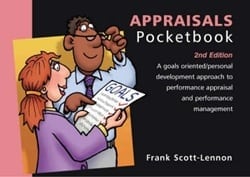Managers and employees are buzzing about the annual performance review. Unfortunately the anticipation isn’t necessarily positive.
 Let’s be honest. The review meeting has become little more than a song-and-dance ritual. If it wasn’t for HR’s mandate that every employee must have this annual appraisal to document performance for the employee file, annual reviews would never get done. For many companies, the review has become no more than a veiled attempt to justify paltry pay increases and to produce the legally defensible documentation in case the employee ever needs to be disciplined, counseled, or terminated.
Let’s be honest. The review meeting has become little more than a song-and-dance ritual. If it wasn’t for HR’s mandate that every employee must have this annual appraisal to document performance for the employee file, annual reviews would never get done. For many companies, the review has become no more than a veiled attempt to justify paltry pay increases and to produce the legally defensible documentation in case the employee ever needs to be disciplined, counseled, or terminated.
For most organizations, the annual performance review has little if anything to do with performance – past, present, or future. It’s the once a year meeting of the minds where an entire year of success and failures are boiled down into a few categories, often selected arbitrarily and unrelated to real productivity and outcomes. These so-called performance meetings are carved out of (or maybe more appropriately squeezed into) a busy schedule to discuss everything that has happened over the last 12 months. What makes matters worse is that over the past five years, a manager’s average number of direct reports has doubled (Corporate Executive Board.) The manager is often rushed and distracted; the employee defensive and anxious.
Over the past few years of difficult economic times, many companies cancel reviews because salaries were frozen or pay increases minimized. The difference between getting a “4” or “5” was career-wise insignificant and often times monetarily irrelevant.
Despite all the negative press and public calls to reform the employee feedback process, performance appraisal season has kicked off in many organizations. But since management still sees the once-a-year review as their most ostensible investment in people management and at the same time a way to pave the legal paper trail, outcomes regrettably will most likely be the same.
Senior management isn’t the only culprit. A major part of the problem rests squarely on the manager’s shoulder. What else would a manager discuss with an employee if it isn’t money?
Here’s a suggestion: talk about last year’s performance as history and look forward. Focus on expectations for the coming months and year. Develop an actual plan for improving performance with realistic, measurable goals. And possibly the most important aspect of managing employees – don’t wait another 12 months to give feedback and hold back on rewards and recognition that are due now.
What are some other solutions?
1. Automate the process. The paper performance review form is ineffective. Tracking down these employee evaluation forms is an administrative nightmare for human resources departments. So much time is spent administering the annual review that performance feedback and goal setting becomes secondary. In effect, more effort and resources are committed to the process than the result. The first step at improving employee performance management is to stop the paper chase. Set your sights on providing employee feedback, not completing paperwork.
2. Evaluate skills and behaviors that matter. One significant mistake companies make is evaluating performance based on very general factors. Another is rating personality traits or characteristics. Positive feedback should be personalized but never get personal. Even if the employee is loud, obnoxious, sloppy and lazy, the evaluation and subsequent subject must focus on actual performance and the consequences of inappropriate or ineffective behavior Factors such as attendance and appearance should never get equal billing and importance with competencies like decisive judgment, getting results, and interpersonal communication. Evaluations and feedback must address skills and behavior that affect performance.
3. Stay focused. Avoid the “sheep-dip” approach where every employee is treated like another. It’s a sure way to turn a performance management event into an irrelevant task. Employee evaluation forms are not meant to be wish lists. In one organization every employee from housekeeping to department directors was evaluated on the same 33 criteria. Another business was proud to show me the 612 different competencies they identified that “aligned” with their strategic goals. Evaluating performance is tough enough without overloading the process with criteria that don’t add value or drive performance. The more criteria, the less time managers will spend critically thinking about individual performance and offering constructive comments. Limit the form and performance feedback to between 5 and 10 core competencies or critical goals and watch the performance review experience improve significantly.
